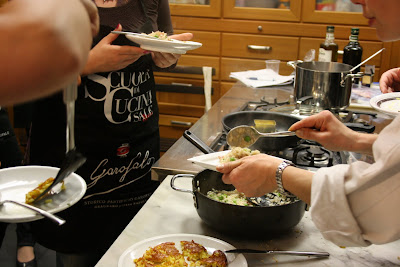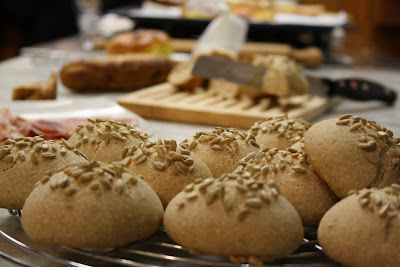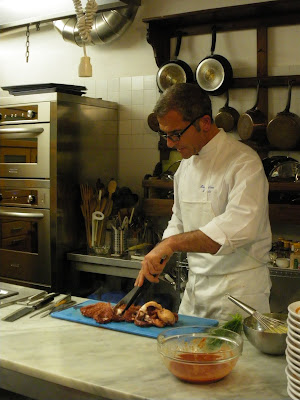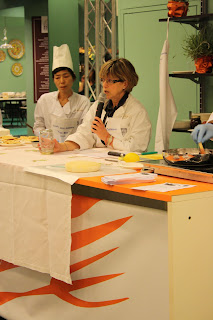 ...nella cucina del Cordon Bleu!Risotto con pisellini primavera
...nella cucina del Cordon Bleu!Risotto con pisellini primavera
Riso selvaggio con finocchio e mandorle
Insalata di riso fredda
Sformato di riso e verdure
Tortino di riso croccante
Budino dolce di riso
Questo le ricette proposte nella lezione organizzata dalla Piccola Accademia di Cucina (Sale & Pepe) tenutasi lo scorso venerdì nella nostra scuola. Una lezione interessante e, come sempre, divertente, non solo per imparare a cucinare, ma anche per far ricredere tutti coloro che si ostinano ancora ad associare al riso un’idea di cucina “depurativa”, poco invitante e tutt’altro che appetitosa. Il riso ha una storia antichissima.
Già coltivato in epoche molto lontane in diverse zone dell’estremo oriente, fu portato in Europa probabilmente dagli Arabi, durante la loro dominazione della Spagna. Le prime testimonianze del suo uso in Italia risalgono al Medioevo, epoca in cui il riso era considerato un ingrediente prezioso e veniva impiegato per lo più in preparazioni medicali e di pasticceria. Per trovare le prime testimonianze di coltivazioni estensive in Piemonte e Lombardia dobbiamo aspettare però la fine del 1400, quando la diffusione divenne inarrestabile e le varietà importate e selezionate in continuo aumento, fino ai giorni nostri.
Attualmente, grazie alla grande diffusione della sua conoscenza e del suo uso, alle sue proprietà nutritive (non solo carboidrati, ma anche proteine e sali minerali) unite ad una elevata digeribilità, e alla versatilità in cucina (ricette dolci, salate, farine, oli, …), il riso può essere davvero considerato il Re dei cereali! Altro che “risetto in bianco”! Solo nella tradizione gastronomica italiana sono conosciute più di 130 ricette, tra antipasti, primi, piatti unici e dolci e chi più ne ha più ne metta.
Sarebbe impossibile passare in rassegna in una sola sera tutti i modi di prepararlo, ma nella lezione di venerdì scorso, con la realizzazione di 5 ottime ricette, abbiamo imparato e messo da parte i segreti fondamentali per cucinarlo nel migliore dei modi. Come tostarlo, il suo fondo di cottura, quale brodo utilizzare, il vino, come sformarlo, come riciclarne gli avanzi e tanti altri piccoli trucchi. E poi alcune delle innumerevoli qualità, dalle più tradizionali e prelibate, come l’Arborio, il Vialone Nano e il Carnaroli, al più raro ed insolito Riso Selvatico.
Dura la scelta tra le diverse ricette, forse al primo posto lo sformato di riso e verdure e l’insalata di riso con carciofi e fave, che così freschi e colorati fanno un po’ Primavera, anche quest’anno che la Primavera (maledetta, come cantava Loretta Goggi) non vuole proprio arrivare! Oppure il riso selvatico, finora guardato con sospetto e curiosità, in quei rari incontri in negozi un po’ esotici, e da oggi in cima alla lista dei prossimi acquisti al supermercato bio. Certo il tortino di riso croccante e il risotto con pisellini e pancetta non sono da meno, per non parlare poi del budino di riso, che ne mangeresti, non puoi mangiarne meno di 3 per volta!
Per celebrare questo tripudio di risi e risotti, la serata non poteva che concludersi con un bel brindisi, perché dicono che “il riso nasce nell’acqua e deve morire nel vino” e noi abbiamo deciso di seguire alla lettera il detto, non solo in cottura, ma anche e soprattutto in degustazione!

Le ricette della lezione ai fortunati che c’erano. A chi non c’era, ma avrebbe voluto, dedichiamo per consolazione questa ricettina extra, fuori corso, e il calendario delle prossime lezioni, augurando comunque a tutti: buon appetito!
RISO ALLA PILOTA (di Emilia Onesti)
per 4 persone
400 gr di riso Vialone Nano
80 gr di burro
150 gr di salamella mantovana o salsiccia poco condita
70gr di parmigiano grattugiato
noce moscata
cannella in polvere
sale
In una pentola di coccio (o altra pentola di materiale pesante) portare ad ebollizione 850ml di acqua. Salare leggermente ed unire un pizzico di cannella. Quando riprende l'ebollizione versare il riso al centro formando un cono il cui vertice deve essere fuori dall'acqua (se non lo fosse levarne un po' con un cucchiaio). Una volta ripreso il bollore scuotere la pentola per far scendere la cima e cuocere per 10 minuti senza mescolare. A cottura ultimata spegnere il fuoco e coprire la pentola il più ermeticamente possibile e far riposare per 15 minuti. Nel frattempo sciogliere il burro in un tegamino e rosolarvi la salamella spellata schiacciandola con una forchetta per disfarla. Salare leggermente e condire con poca noce moscata ed un pizzico di cannella. Trascorso il tempo di riposo del riso sgranarlo con la forchetta ed unirvi il sugo di salamella ed il parmigiano. Servire subito. Attenzione alle dimensioni della pentola: se è troppo larga il liquido evapora troppo velocemente ed il riso risulta troppo asciutto.
***
Risotto with leattle peas and bacon
Wild rice with fennel and almonds
Rice salad with artichokes and broad beans
Crispy rice cake
Sweet rice pudding
Last Friday an amazing lesson about the above recipes and organized by the Piccola Accademia di Cucina (Sale & Pepe) was held at our school.It was interesting and, besides learning cooking, useful to change the mind of those who still associate to the rice an idea of “depurative” cooking, uninviting and far from appetizing. Rice has an ancient history.
It was cultivated in different parts of the Far East in ancient times, it was probably brought to Europe by the Arabs during their domination of Spain. The first evidence of its use in Italy dates back to medieval times where the rice was considered as a precious ingredient and was used mostly in medical and pastry preparations. We must wait the end of 1400 to find the first evidence of the extensive farming in Piemonte and Lombardia, when its high spread became unstoppable and the selection and growing of many varieties started and continues until now.
Today the rice can be really considered the King of cereals, thanks to its widespread, its nutritional properties (not only carbohydrates but also protein and minerals) combined with a highly digestibility and its versatility (sweet and salted recipes, flour, oil, …). More than 130 recipes are known in Italian cuisine, including appetizers, pasta, main dishes and sweets.
It is impossible to exhaust the topic with just one evening, but during the lesson last Friday, with five great recipes, we learned the tricks of the best way to cook it. How to roast it, the liquor and the broth, the wine, how to make it as a flan, how to recycle leftovers and many other little tricks. Lastly, some information about different qualities: from the more traditional and delicious ones, such as Arborio, Vialone Nano and Carnaroli, to the rear and unusual Wild Rice.
The choice between the different recipes is hard, perhaps the rice pudding with vegetables and the rice salad rank first, so fresh and colourful like the missing Spring, that we are still waiting for. Maybe the wild rice, regarded with suspicion and curiosity, now on the top of next shopping list at the bio-market. Of course the crispy rice cake and risotto with peas and bacon are not inferior to the rest. Not to mention the rice pudding, you cannot eat less than 3 at a time!
The night could not end without a nice toast to celebrate this feast of rice and risotto. As the saying goes: “rice is born in water and must die in wine” and we decided to follow this lovely saying not only for cooking, but especially for tasting!
The recipes go to the lucky ones whom attended the lesson. We dedicate the following extra recipe and the calendar of next lessons to whom was not there, but wanted to be, to comfort them for missing this lovely lesson! However we wish all of you: bon appétit!
RISO ALLA PILOTA (by Emilia Onesti)
for 4
400 gr rice Vialone Nano
80 gr butter
150 gr of Mantuan sausage or sausage not too much flavored
70 gr grated parmesan cheese
Nutmeg
Cinnamon
Salt
Put 850 ml of water in an earthenware pot. Add a bit of salt and a pinch of cinnamon and bring it to the boil. Put the center, making a cone whose apex is to be out of the water (if not, take out a bit of water with a spoon). Once the water go back to the boil, shake the pot to bring down the top and cook for 10 minutes without stirring. When cooked, turn off the heat and cover the pot tightly and let rest for 15 minutes. Meanwhile melt butter in a little saucepan and brown the sausage skinned crushing it with a fork. Add salt and season lightly with a little bit of nutmeg and a pinch of cinnamon. 15 minutes after, crumble the rice with a fork and serve the rice wiht the sausage sauce and parmesan. Serve immediately. Minnd the size of the pot: if too large, the liquid evaporates too quickly and the rice get too dry.
 Si dice buono come il pane, perché il pane non è soltanto buono da mangiare. È buono il suo odore, quello del lievito che sprigiona durante la cottura e quel delicato profumo un po’ biscottato del pane appena sfornato. È buono il suo sapore, nelle sue mille varianti, da solo o in compagnia di uno stuzzicante companatico.
Si dice buono come il pane, perché il pane non è soltanto buono da mangiare. È buono il suo odore, quello del lievito che sprigiona durante la cottura e quel delicato profumo un po’ biscottato del pane appena sfornato. È buono il suo sapore, nelle sue mille varianti, da solo o in compagnia di uno stuzzicante companatico. La magia della lievitazione.
La magia della lievitazione. La maestria del dosaggio degli ingredienti di base e la fantasia nella scelta di quelli “personali”.
La maestria del dosaggio degli ingredienti di base e la fantasia nella scelta di quelli “personali”.
 La cura dell’impasto, maneggiato con amorevole dolcezza.
La cura dell’impasto, maneggiato con amorevole dolcezza. La conoscenza e l’esperienza della cottura. Componenti essenziali per la riuscita di un prodotto che di buono non avrà soltanto il sapore, ma i sentimenti trasmessi da chi con tali abilità lo ha preparato.
La conoscenza e l’esperienza della cottura. Componenti essenziali per la riuscita di un prodotto che di buono non avrà soltanto il sapore, ma i sentimenti trasmessi da chi con tali abilità lo ha preparato. Cosa c’è di più amabile che entrare in una cucina dove, dopo ore di lenta lievitazione, sta iniziando a cuocere un filone di pane o una gustosa focaccia? Il tepore e il profumo rassicuranti da cui si è avvolti, cancellano in un istante tutte le fatiche e i brutti pensieri. Soprattutto in inverno, quando fuori fa freddo e i vetri appannati dal calore del forno svelano all’esterno il conforto di un cibo semplice e speciale.
Cosa c’è di più amabile che entrare in una cucina dove, dopo ore di lenta lievitazione, sta iniziando a cuocere un filone di pane o una gustosa focaccia? Il tepore e il profumo rassicuranti da cui si è avvolti, cancellano in un istante tutte le fatiche e i brutti pensieri. Soprattutto in inverno, quando fuori fa freddo e i vetri appannati dal calore del forno svelano all’esterno il conforto di un cibo semplice e speciale. Pane classico, focacce, panini brioche allo zafferano, mini baguette alle noci, pizza margherita, panini integrali con i semi.
Pane classico, focacce, panini brioche allo zafferano, mini baguette alle noci, pizza margherita, panini integrali con i semi. Qualcosa di raffinato.
Qualcosa di raffinato.
 Queste le preparazioni eseguite durante la lezione dello scorso 26 Novembre, in collaborazione con Piccola Accademia di Cucina.
Queste le preparazioni eseguite durante la lezione dello scorso 26 Novembre, in collaborazione con Piccola Accademia di Cucina. Tutte proposte interessanti e buonissime da preparare in casa per stupire e confortare amici e parenti, sperando che arrivi il freddo necessario ad appannare le nostre finestre...!
Tutte proposte interessanti e buonissime da preparare in casa per stupire e confortare amici e parenti, sperando che arrivi il freddo necessario ad appannare le nostre finestre...!










 La ricetta è di Francesca Ottanelli, gestore del rifugio. Il suo trucco è di lavorare pochissimo l’impasto: conferisce un effetto “rustico” alla crostata, che sembra fatta con farina integrale.
La ricetta è di Francesca Ottanelli, gestore del rifugio. Il suo trucco è di lavorare pochissimo l’impasto: conferisce un effetto “rustico” alla crostata, che sembra fatta con farina integrale.


 Il bello e bravo chef del Gambero Rosso ci ha regalato una serata veramente indimenticabile, non solo perchè ha cucinato per noi delle ottime ricette, ma anche per la simpatia con cui ci ha piacevolmente intrattenuto per 3 ore, spiegando passo per passo l'esecuzione di alcuni piatti, che abbiamo poi degustato, e dispensando preziosi consigli e qualche utile suggerimento.
Il bello e bravo chef del Gambero Rosso ci ha regalato una serata veramente indimenticabile, non solo perchè ha cucinato per noi delle ottime ricette, ma anche per la simpatia con cui ci ha piacevolmente intrattenuto per 3 ore, spiegando passo per passo l'esecuzione di alcuni piatti, che abbiamo poi degustato, e dispensando preziosi consigli e qualche utile suggerimento. Lui è proprio come appare in televisione: bravo, simpatico, energico. Un fiume in piena di entusiasmo e allegria!
Lui è proprio come appare in televisione: bravo, simpatico, energico. Un fiume in piena di entusiasmo e allegria!

 L'importanza degli ingredienti: cose semplici, fresche e di prima qualità, genuine.
L'importanza degli ingredienti: cose semplici, fresche e di prima qualità, genuine.  Meglio se provenienti dai territori di produzione. L'importanza di utilizzare strumenti adeguati, per facilitare l'esecuzione senza compromettere il sapore dei cibi.
Meglio se provenienti dai territori di produzione. L'importanza di utilizzare strumenti adeguati, per facilitare l'esecuzione senza compromettere il sapore dei cibi.
 Un vero successo, che speriamo di poter ripetere al più presto ospitando di nuovo Max dopo l'estate, in una lezione aperta a tutti gli interessati, di cui vi informeremo per tempo.
Un vero successo, che speriamo di poter ripetere al più presto ospitando di nuovo Max dopo l'estate, in una lezione aperta a tutti gli interessati, di cui vi informeremo per tempo. Intanto un grazie di cuore a Max e all'Accademia del Sapore Lagostina per la bella serata che ci hanno offerto mercoledì!
Intanto un grazie di cuore a Max e all'Accademia del Sapore Lagostina per la bella serata che ci hanno offerto mercoledì!









